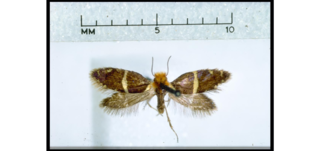
Sabatinca ianthina is a species of moth belonging to the family Micropterigidae. It was described by Alfred Philpott in 1921. It is endemic to New Zealand. This species can be found on both the North and the South Islands from the Hawkes Bay down to Westland. The adults of this species are on the wing from the end of September until the middle of December. Although this species resembles Zealandopterix zonodoxa, S. ianthina is a larger moth and the range of the two species only overlaps in White Pine Bush Scenic Reserve in the Hawke’s Bay.
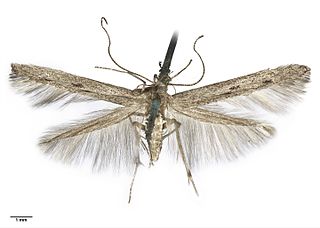
Batrachedra astricta is a species of moth in the family Batrachedridae. It is endemic to New Zealand. It is found in the north of the North Island and also Opoho in Otago. This species is on the wing in December. B. astricta has been found in wetland habitat. It has been shown to be associated with the threatened plant Sporadanthus ferrugineus.
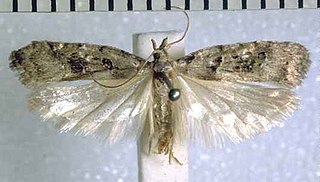
Heterocrossa canescens is a species of moth in the family Carposinidae. It is endemic to New Zealand. This species has been observed in Aoraki / Mount Cook National Park and in the Southern Alps. The larvae of this species feed on the fruits and flowers of endemic to New Zealand species in the genus Gaultheria. Adult moths are on the wing in November and from January to March.
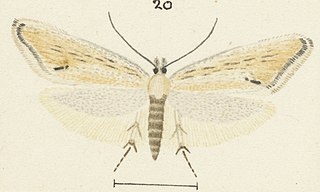
Glyphipterix necopina is a species of sedge moth in the genus Glyphipterix. It is endemic to New Zealand. It is classified as Not Threatened by the Department of Conservation.

Elachista sagittifera is a species of moth in the family Elachistidae. It was described by Alfred Philpott in 1927. It is endemic to New Zealand and is known from Arthur's Pass. It is similar in appearance to Elachista thallophora. Adults are on the wing in February.

Anisoplaca fraxinea is a species of moth of the family Gelechiidae. It was described by Alfred Philpott in 1928 and is endemic to New Zealand. It has been observed in the South Island and adults are on the wing in February and March.

Anisoplaca ptyoptera is a species of moth in the family Gelechiidae. It was described by Edward Meyrick in 1885 and is endemic to New Zealand. This species is found throughout the North and South Islands and prefers habitat where its host plants are common. The larval hosts of this moth are species in the genus Carmichaelia and the larvae stem mine the host plant. However larvae have also been observed feeding on gorse species and as a result their potential as a biological control for gorse has been researched. This behaviour has only been recorded in the Canterbury and Otago regions. A. ptyoptera overwinters as larvae and while in that life stage can be parasitised by species of wasp in the genera Zealachertus and Diadegma. Pupation begins in October. Adult moths are on the wing from October until May with peak emergence occurring in January. The adult moths come in two size classes and should the size of the female be in the larger class fecundity is improved. It is likely that this species has only one brood a year.

Sagephora jocularis is a species of moth in the family Tineidae. It was described by Alfred Philpott in 1926. This species is endemic to New Zealand and has been collected in Canterbury and Southland. Adults are on the wing in January and October.
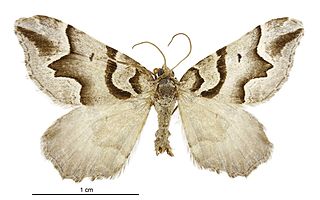
Helastia expolita is a moth of the family Geometridae. This species is endemic to New Zealand and occurs in the Buller, Marlborough, North and Mid Canterbury regions.This species inhabits short tussock grassland in montane to subalpine zones. Adult moths are nocturnal but little is known about the life history of H. expolita. Adults have been observed on the wing in November. It has been hypothesised the larvae of H. expolita feed on the flowers of Helichrysum species and then feed on mosses, lichens or shrubs growing nearby. It is classified as "At Risk, Relict'" by the Department of Conservation.
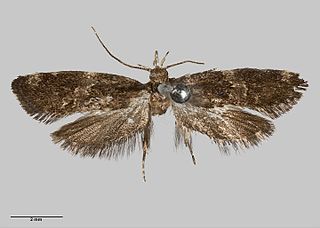
Trachypepla nimbosa is a species of moth in the family Oecophoridae. It is endemic to New Zealand. This species has been collected in Auckland as well as one specimen in the West Coast. Adults are on the wing in January however the West Coast specimen was collected in November. This species is classified as "Data Deficient" by the Department of Conservation.

Hierodoris eremita is a moth of the family Oecophoridae. It is endemic to New Zealand and found in the areas around Aoraki / Mount Cook and Westland Tai Poutini National Park areas. This species inhabits alpine herbfields at altitudes of around 900–1400 m. Larvae are said to have been reared on the leaves of plants in the Celmisia genus. Pupation happens on the host plant. The adults of this species is on the wing between December and June. This species is day flying.
Mallobathra tonnoiri is a moth of the family Psychidae. This species is endemic to New Zealand.

Tingena maranta is a species of moth in the family Oecophoridae. It is endemic to New Zealand and is found in the lower South Island. Adults of this species are on the wing from October until January. This species prefers grass or low herb habitat. Unlike its close relatives it does not inhabit native forest.
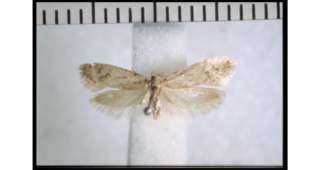
Tingena pallidula is a species of moth in the family Oecophoridae. It is endemic to New Zealand and has been collected in the Nelson and Tasman regions. Adults of this species are on the wing in February and have been collected by beating undergrowth.
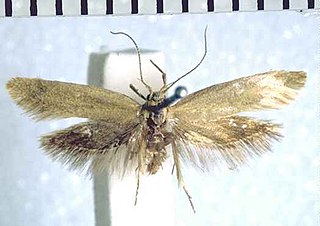
Tingena paula is a species of moth in the family Oecophoridae. It is endemic to New Zealand and has been observed in Canterbury. Adults of this species are on the wing in November.

Tingena robiginosa is a species of moth in the family Oecophoridae. It is endemic to New Zealand and has been observed in the southern parts of the South Island. It has been observed in subalpine habitats at altitudes of between 2700 and 3500 ft amongst Hebe and Cassinia species. The adults of this species are on the wing in December and January.

Meterana badia is a species of moth in the family Noctuidae. This species is endemic to New Zealand.
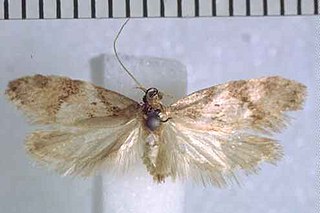
Trachypepla angularis is a species of moth in the family Oecophoridae. It is endemic to New Zealand and has been collected at Lake Rotoroa in the Nelson Lakes National Park in January. This species inhabits mixed native forest.

Trachypepla minuta is a moth of the family Oecophoridae first described by Alfred Philpott in 1931. It is endemic to New Zealand and has been collected in Auckland. Adults of this species are on the wing in December. It is distinguishable from similar species as it is smaller in size and darker in appearance than other species in the genus Trachypepla.

Trachypepla protochlora is a moth of the family Oecophoridae first described by Edward Meyrick in 1883. It is endemic to New Zealand and is found in both the North and South Islands. The preferred habitat of this species is native forest and adults are on the wing from October until February. Adults can be variable in their green shaded colour as well as in the intensity of markings on their forewings. The greenish ground colouration of this moth ensures they are well camouflaged when at rest on green mosses and lichens.





















